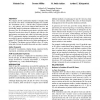Free Online Productivity Tools
i2Speak
i2Symbol
i2OCR
iTex2Img
iWeb2Print
iWeb2Shot
i2Type
iPdf2Split
iPdf2Merge
i2Bopomofo
i2Arabic
i2Style
i2Image
i2PDF
iLatex2Rtf
Sci2ools
CHI
2004
ACM
2004
ACM
Combining 2D and 3D views for orientation and relative position tasks
We compare 2D/3D combination displays to displays with 2D and 3D views alone. Combination displays we consider are: orientation icon (i.e., side-by-side), in-place methods (e.g., clip planes), and a new method called ExoVis. We specifically analyze performance differences (i.e., time and accuracy) for 3D orientation and relative position tasks. Empirical results show that 3D displays are effective for approximate navigation and relative positioning whereas 2D/3D combination displays (orientation icon and ExoVis) are useful for precise orientation and position tasks. Combination 2D/3D displays had as good or better performance as 2D displays. Clip planes were not effective for a 3D orientation task, but may be useful when only one slice is needed. Author Keywords 2D and 3D visualization, display design, empirical study, experiment, orientation and relative position tasks. ACM Classification Keywords H.5.2 User Interfaces - Graphical User Interfaces (GUI), Screen Design, Evaluation/Meth...
CHI 2004 | Combination 2D/3D Displays | Combination Displays | Human Computer Interaction | Relative Position Tasks |
| Added | 01 Dec 2009 |
| Updated | 01 Dec 2009 |
| Type | Conference |
| Year | 2004 |
| Where | CHI |
| Authors | Melanie Tory, Torsten Möller, M. Stella Atkins, Arthur E. Kirkpatrick |
Comments (0)

